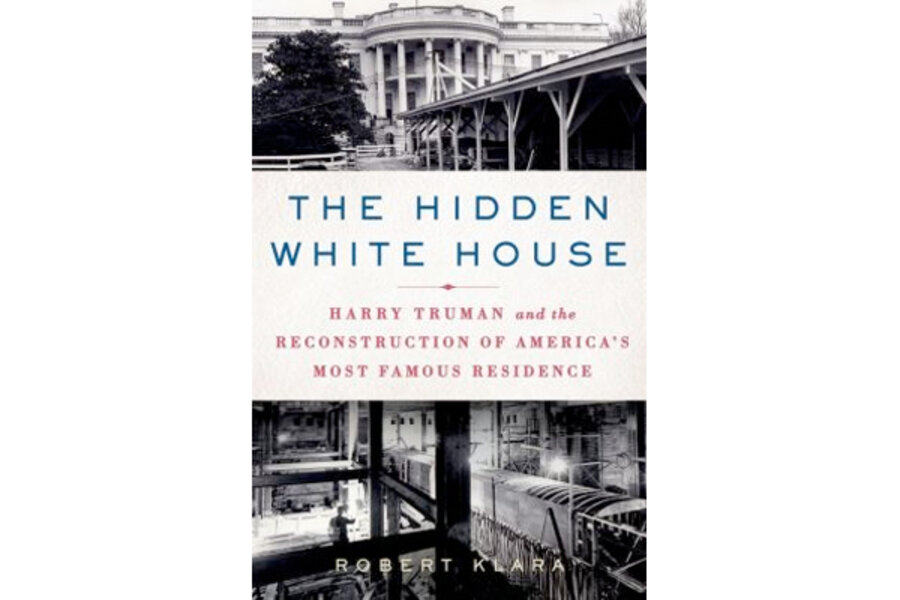The Hidden White House
Loading...
The White House may be the best-known building in the world. What is little known today is that shortly after the Second World War, having been weakened by decades of neglect, it almost collapsed. The fascinating story of how such an iconic structure fell into disrepair and how it was saved is the subject of Robert Klara’s latest book, The Hidden White House: Harry Truman and the Reconstruction of America’s Most Famous Residence.
For most of the nation’s history, little attention was paid to the physical integrity of the White House itself. The mansion was largely rebuilt twice, first after the British burned it during the War of 1812, and then again in 1902, under the direction of President Theodore Roosevelt. But after that, few changes were made and even basic upkeep, especially of the first family’s living quarters, was largely ignored. According to Klara, when Bess Truman initially saw her new home she found it dingy, in disrepair, and infested by rats. Even the usher who showed her around said that the place looked like “an abandoned hotel.”
By 1948, things were plainly dangerous. In one dramatic incident, a huge chandelier in the East Room almost collapsed during a reception and in another, the leg of Margret Truman’s piano fell through floor of her bedroom. Quick investigations of these incidents painted an alarming picture. One report noted that “the second floor was unsafe and almost in danger of falling down.” The beams of the house were “bone dry, brittle and laced with cracks.” The head of the government’s Public Buildings Administration admitted that the White House was not safe for human habitation and wrote that “the beams are staying up there from force of habit only.”
But despite the obvious hazards, the Trumans remained in residence. The reason was political – Truman’s uphill battle for reelection might have been fatally undermined if word had gotten out that the White House was collapsing around him.
Any pretense about the severity of the problems was abandoned after the election. The building was quickly closed to visitors and, when the Trumans relocated to Blair House, The Washington Post proclaimed “White House on the Verge of Collapse.” This was no minor remodeling; Klara calls it, to use a contemporary term, a “gut remodel.” When confronted with the $5.6 million price tag, some in Congress wanted to tear down the venerable building and simply construct a replacement.
To save the structure, everything but the four exterior walls was demolished and a steel frame was built into the structure to support the walls and the roof. The exterior walls themselves had to be propped up while a foundation was constructed underneath them to help carry the great weight of the building.
This being Washington, the construction took longer than expected and political intrigue was a constant. And, as with any home renovation project, unexpected problems suddenly emerged: After the Soviet Union exploded an atomic bomb, engineers were ordered to add a bomb shelter. Costs rose and, when Congress declined to provide more resources, the project ran out of money.
As a result, elaborate plans for an appropriate interior with fine furnishings were abandoned. Furniture was scrounged from any reasonable source with no thought to authenticity or appropriateness, leaving the White House with a “budget-hotel look” that would last until Jackie Kennedy undertook her highly successful and greatly admired restoration project.
In this marvelous book, Truman is both a hero and a villain. Klara gives him full credit for the preservation of the White House – without him, the building might well have been wrecked. But, at the same time, Truman made serious compromises. Most notably, many of the original doors, windows, mantelpieces, moldings and wood paneling were carefully packed away to be reinstalled. But because the restoration of the original materials was labor- and time-intensive, most of the original interiors were later discarded in favor of modern reproductions. Some of the priceless materials were used for other purposes – large parts of the original floor became a roller rink at a nearby army base – and the rest were simply sent to a landfill.
This book is popular history at its best: a little-known but compelling story told by an excellent writer. One hopes it gets widespread attention because it teaches much about the history of this priceless landmark and serves as a reminder of how close we came to losing it. It also provides a valuable reminder of how the decisions we make about historic treasures today will affect the way that generations yet unborn experience them in the future.
Terry Hartle is senior vice president of government relations for the American Council on Education.








